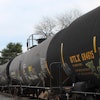"There was a lot of dust floating in the air and settling on equipment," he says. "We feared it was compromising our pledge to maintain a safe, comfortable work zone for our employees."
Shamrock enlisted the State of Florida to perform an air quality test, which confirmed that the plant's dust problem was severe enough to be well out of compliance with OSHA standards. Gillon began looking for ways to bring the plant into compliance.
Shamrock's plant is divided into two sections: part production and boat assembly, and both generate significant amounts of nuisance dust that was left to float around the plant. During part production, for example, large amounts of debris are created, especially during the lamination process. This involves laying out fiberglass to create a boat shell, pulling out the mold, and trimming and grinding the parts to finish the basic shell. The trimming and grinding produce the bulk of the dust. Previously, Shamrock provided respirators for each worker. But because the dust generated by grinding and trimming was never collected, it remained in the air.
The boat-assembly stage involves drilling and fastening the parts for each boat, which leaves debris in the boat hulls. Shamrock previously blew this debris out of the hull with an air hose. While this eliminated dust from the hulls, it also circulated it around the plant.
Gillon contacted Nilfisk-Advance America, a Malvern, PA-based maker of industrial vacuum cleaners for help with the dust problem. Gillon and a district sales manager performed an analysis of the Shamrock plant and its processes, and together devised a cost-effective dust cleaning system. The core of the program was the integration of vacuum cleaners into Shamrock's production processes. The company first connected the Nilfisk GM 811 vacuum to its cutting saws. These saws do the trimming and grinding during part production. With the Nilfisk-Advance America vacuum, workers were now able to pull dust and debris away from the cut as it is made, collecting and retaining it within the vacuum for safe disposal. During boat assembly, the vacuum captures the debris at the bottom of each boat hull, replacing the less-effective air-hose method. The vacuum both prevents dust from being circulated and ensures a safer working environment.
To complement the two production applications and keep other areas of the plant clean, Shamrock also purchased a portable, Nilfisk GM 83 for general plant maintenance and cleaning. This unit enables workers to reach overhead pipes as well as clean walls, air filters, floors, machines and aisles. When the GM 83 is not being used for maintenance it is used in production with up to three power-tool attachments.
According to Nilfisk, the GM 811 and GM 83 are equipped with a heavy duty trolley giving the vacuums ability to move around the plant, as well as a HEPA (High Efficiency Particulate Air) filter that ensures that 99.97% percent of all ultra-fine particles, toxic and nuisance, are retained in the vacuums. A large main filter ensures a steady, even airflow which extends filter life and eliminates premature clogging.
Since adding the units, "We've seen a major drop in the amount of dust in our plant," says Gillon. He adds that the units have improved air quality in the plant by more than 94%, helping workers breathe easier, and returning the facility to OSHA compliance.


















